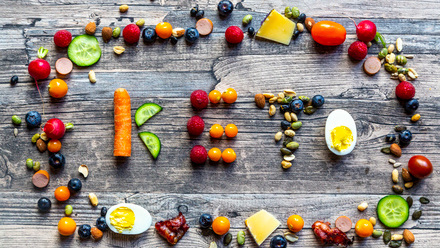by Hannah Ellis is a paediatric dietitian (Neurology and Ketogenic diet) at Bristol Royal Hospital for Children.
The ketogenic diet is a recognised non-invasive treatment for intractable epilepsy. It is a highfat, low-carbohydrate diet with moderate amounts of protein, which mimics starvation and forces the body into ‘ketosis’ – the process by which ketones are produced by the liver and are used to fuel the body’s cells and brain instead of glucose.
The exact mechanism of how the diet works isn’t yet known, however, it appears to reduce the abnormal electric activity in the brain which can cause seizures. This may be due to the direct action of the ketones produced or the metabolic changes associated with ketosis. In paediatrics, the therapeutic range for ketones is 2.5-5mmol/l.
At Bristol Royal Hospital for Children we provide a ketogenic service to 90 patients located across South West England and South Wales. The ketogenic diet is highly restrictive and requires close supervision and monitoring by ketogenic dietitians. The ketogenic diet is successful in reducing seizures by >50% in around one-third of patients with intractable epilepsy. Onethird of patients will experience some improvement in seizure activity and one-third will, unfortunately, show no improvement. However, the practicalities of the diet and compliance are often large contributing factors to continuing and maintaining the diet for many of our patients.
What do keto dietitians do?
Ketogenic dietitians spend a considerable amount of time calculating dietary prescriptions, creating recipes and finetuning the ketogenic diet for patients. The ketogenic diet is not an easy diet to follow and requires full commitment from families of children undertaking it. Meals have to be carefully planned and prepared and food needs to be accurately weighed.
We regularly hear of frustrations from families who spend a long time creating recipes, for the end result not to be as they expected or for their child to refuse it. We wanted to experience the ketogenic diet from the families’ perspective and learn from this.
My keto diet diary
Pre-diet I decided to trial the modified Atkins diet and allowed myself three meals and two snacks per day. I spent the weekend planning my meals which involved creating a shopping list and trips to multiple supermarkets. I needed to check food labels for the lowest carbohydrate options and source some quite difficult-to-find items including oils, nut-based flours and carbohydrate-free sweeteners and baking powder. Many of the low carbohydrate, suitable products were difficult to locate, even in larger supermarkets. Some products had to be sourced online and, overall, I found the initial shop very expensive and time-consuming compared to my usual weekly shop. This made me appreciate how overwhelming shopping for the ketogenic diet can be for new patients.
Days 1-3
Despite all the planning, I still felt quite unprepared starting the diet. I was finding inspiration from recipes that I wanted to try, however I struggled to find the time and correct ingredients to experiment properly.
The first 48 hours on the diet were very challenging. Getting out of bed in the morning had never been so difficult and my brain felt very foggy. Some patients refer to the term ‘keto flu’ when starting the diet as a description of their symptoms of tiredness, nausea, headaches and irritability.
I felt hungry and I was thinking about food all the time. I psychologically struggled with the portion sizes as, typically, ketogenic meals are smaller due to being so energy dense. I now empathise with the difficulties of being presented with a meal which is significantly smaller than what you are used to, a common concern expressed by parents.
Additionally, I was very thirsty and experienced increased urination. My weight dropped by 1kg within the first three days due to the dehydrating nature of the ketogenic diet, caused by depletion in the bodies glycogen stores.
Days 4-6
My bowels did not open for the first four days; I was aware constipation was a common sideeffect but found this quite concerning.
Within the first five days I began to make ketones in the range of 1-2mmol/l. I became aware that I was becoming a bit obsessed with testing my ketones, I appreciated how it can be easy to become fixated on ketone levels over symptoms.
I ate out one night; this involved a lot of preparation. I called the restaurant in advance and I was impressed by how accommodating they were. Nevertheless, I did feel uncomfortable making special requests to the waiter and chef and having to explain myself. I didn’t take my scales with me to the restaurant which meant that I had to estimate everything I had eaten, and I definitely ate more than I was supposed to!
On day five, I experienced symptoms of dizziness, nausea and lethargy. I tested my blood glucose levels and realised I was hypoglycaemic. As per our patient protocol, I knew I needed to treat this with some carbohydrate, however knowing this would cause a drop in my ketones, which I had worked so hard to achieve, made me feel very anxious.
Days 7-10
As I anticipated, my first weekend on the diet was hard. At work we were sharing ketogenic food and motivating each other. However, complying with the diet on my own when around friends and family, who were eating normally, was tough. It is important to acknowledge that this is the reality for our patients. A lot of parents are preparing ketogenic meals alongside their usual family meals whilst having to explain to their child why they can’t have what their brothers and sisters are eating.
I was away for the weekend, which meant I had to be very prepared, carrying plenty of ingredients with me on the train. The weather was lovely and I really wanted ice- cream. I did however manage to avoid temptation and packed an enjoyable ketogenic lunch, which kept me going all day in the hot weather at the beach!
A week into the diet and my ketone levels were between 2-3mmol/l. I was beginning to feel my energy levels increasing and no longer felt like I needed a nap in the afternoon, despite being very busy! That being said, usually after work I tend to go for a run or go to a gym class but whilst on the diet, I just didn’t have the energy or the time.
Days 11-12
My ketones unexpectedly dropped and I couldn’t figure out why. I found this quite disheartening as I had been working so hard and had been strict with my diet. When similar situations happen with my patients, I can be quick to assume changes in ketones are due to a mistake in the diet or a miscalculation. It’s important to accept that ketones can be affected by many different factors including hormone changes, activity levels and illness.
Throughout the second week on the diet my feelings of hunger were starting to settle and I was getting used to my diet plan.
However, I went out for lunch one day and completely lost control and ate so many snacks which weren’t factored into my plan. It was impossible to calculate what I had consumed retrospectively and I felt stressed that I didn’t know my allowance for the rest of the day. It is important to acknowledge that having a ‘slip up’ on the diet for us resulted in nothing more than slight frustration when ketone levels dropped. For many of our patients on the diet, the consequence is a lot more significant (i.e. seizures may return).
The challenges of the keto diet
As we undertook the keto challenge as a group, here are the main challenges that we found collectively:
- Cost
The cost of following this diet was definitely something that was noticed very quickly. Ingredients were difficult to find and food shopping was very timeconsuming. There are certain brands/products that we tend to recommend to our patients as we know the ingredients are suitable, however, when out shopping I did notice that there are many appropriate supermarket own-brand alternatives which could cut the costs. It is however important to appreciate that this takes a lot of label reading and product comparison which is all very timeconsuming and may not be realistic to expect a parent to do.
- Time
By far, the greatest challenge experienced by all of us was the time required to plan and prepare meals every day alongside a working day. Evenings were taken up completely by shopping, planning, cooking and then preparing for the following day.
- Constipation
Most of us experienced quite a significant bout of constipation as our bodies transitioned away from a wholegrain and fibre-rich diet. It was definitely a struggle to get enough nonstarchy vegetables into the diet to keep us regular.
- No days off
Weekends, eating out and social occasions were not easy whilst on the ketogenic diet. It is important to recognise that we chose a two-week period to trial the diet and selected a time period when we had minimal plans (no birthdays, no weddings to attend, no holidays). Our patients don’t have a choice and there are no ‘days off’ the diet. Christmas, birthdays, social events and every weekend all require adaptations to their family norms.
‘Take Home’ message
The ketogenic diet can achieve wonderful, life-changing benefits for children who have intractable epilepsy and for their families. It is a non-invasive and rewarding treatment for many patients.
Nevertheless, the ketogenic diet is not a simple diet to follow and patients and their families face many challenges. Exposing ourselves to these challenges by attempting to meet the expectations that we set for our patients has been an invaluable experience. Being able to advise and empathise with patients based on personal experience is already resulting in a change to the way we are practising.




